- Yes
- No
Martin B-57G: Under a Tropic Moon

I. Absent Interdictor
The Interdiction mission is a specific attack mission that demands long range, high speed and high precision. The earliest aircraft to fit such a role in American service was the A-26 Invader, which partook in limited strikes in both the Pacific and European theaters in the late stages of WW2, proving especially successful in strikes against Northern Italy’s Po river valley. Not long after WW2, the A-26 would be called again, this time used against North Korea. However, due to the surprising emergence of modern jet-powered, Soviet-supplied, MiG-15 fighters, the A-26 was quickly made outdated and vulnerable.
In response to the A-26’s inadequacy in the jet age, a replacement was urgently sought for a rapid light bomber. Unusually, a foreign model wound up being selected – the English Electric Canberra. Due to manufacturing limits, Martin would be tasked with license production of the type, now named B-57. In the rush to get the Canberra into service, the initial B-57A would be an exact copy of the Canberra. However, as the Korean War stalemated, Martin was now given time to thoroughly revise the Canberra, producing the better-suited B-57B. The new aircraft was now armed with forward firing guns, and numerous external pylons for the installation of a plethora of new bombs and rockets.
As the 1950’s turned into the 1960’s, it seemed the B-57B would be imminently retired. After all, U.S. doctrine had moved entirely away from subsonic aircraft, or precision ground strike, opting instead for supersonic nuclear delivery or even ICBM’s. However, as fate would have it, the 1958 Taiwan Strait Crisis would keep the B-57 squadrons on alert in South Korea, for a few years, just long enough for the Gulf of Tonkin incident to happen. With news of this escalation, the B-57B’s were moved to Bien Hoa to carry out strikes against North Vietnamese supply lines supplying the Viet Cong insurgents. These strikes, carried out at night, highlighted the Air Force’s complete lack of night attack capability. The poor effectiveness of the night strikes were a serious liability to the war effort, in December of 1965, President L. B. Johnson would personally order the U.S. Air Force to come up with a solution – resulting in Operation Shed Light.
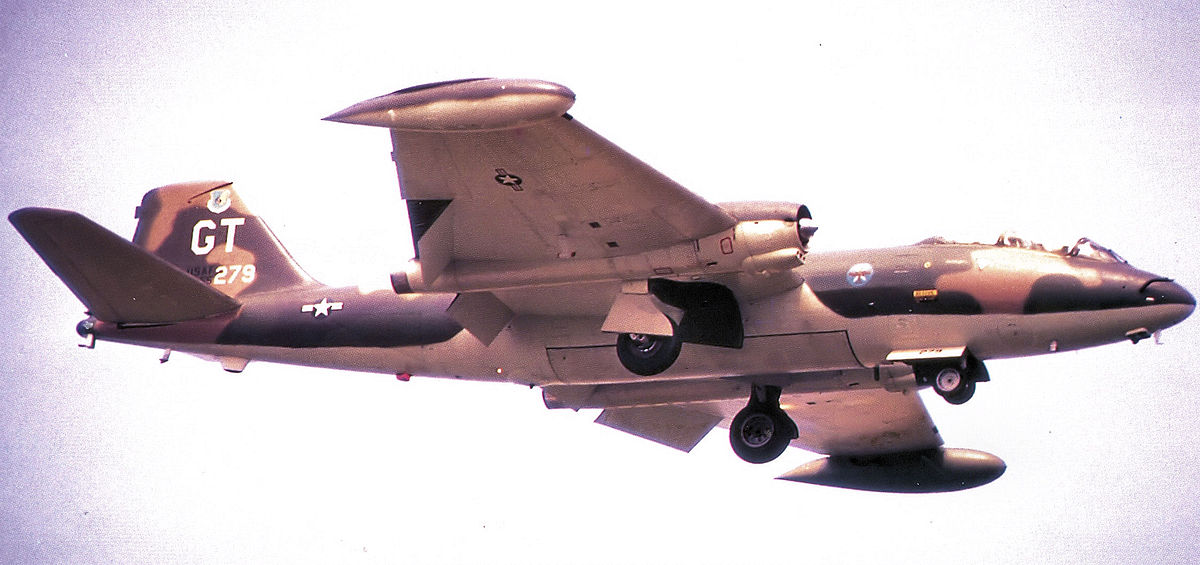
II. Shed Light & Tropic Moon III
Operation Shed Light was enacted to tackle the problem of strike aircraft blinded in nighttime conditions. To solve this issue, a new pair of sensor pods would be developed by Dalmo-Victor (Tropic Moon I) and Westinghouse (Tropic Moon II) for use by the twin-seat A-1E and B-57B. Both pods were fitted with an LLLTV (low-light level television), however, only the Westinghouse unit also contained a laser rangefinder. The first system, Tropic Moon I, was only fitted to the Skyraider and immediately proved inadequate. The second system, Tropic Moon II, would actually see service, but after 182 sorties and 456 targets detected, only 89 were ever destroyed, leading to Tropic Moon II’s withdrawal in 1968.
The definitive Tropic Moon III would combine the sensor pack from Tropic Moon II, as well as a FLIR (forward looking infrared) system previously tested on an A-26 (Operation Lonesome Tiger) into one package. Additionally, Tropic Moon III included a new GMTI (ground moving target indicator) radar system, the AN/APQ-139, based on the A-7D Corsair II’s AN/APQ-126. The entire sensor suite was to be built into the aircraft - the radar installed in the nose, and the LLLTV/FLIR/laser pack installed in a gimballed chin mount. All four sensors were routed through a sophisticated 32 kb digital computer and display system, the AN/AXQ-5 and AN/AXQ-7, allowing the operator to simultaneously control and swap between all four systems. An advanced LORAN navigation system would be included, to help precisely guide the B-57G towards the target. The AN/ALT-28 jammer was included for defense against radar-guided SAM’s, and although rarely used, was retained, as removing the 600 lb. unit would negatively impact crew morale and necessitate the installation of a 500 lb. ballast. On the other hand, the M39 20 mm cannons had to be removed. Outside of sensors and avionics, upgrades included a pair of 30 KVA generators, each mounted below the jet engines, to provide constant power for the numerous electronic systems. The fuel tanks were all modified to be self-sealing using polyurethane foam, and armor against small-arms fire was applied to protect fuel lines, control hydraulics/cabling, and crew positions. In total, sixteen B-57B’s were modified by Martin-Marietta, Westinghouse, and Texas Instruments, and designated as B-57G.
B-57G: Modified nose
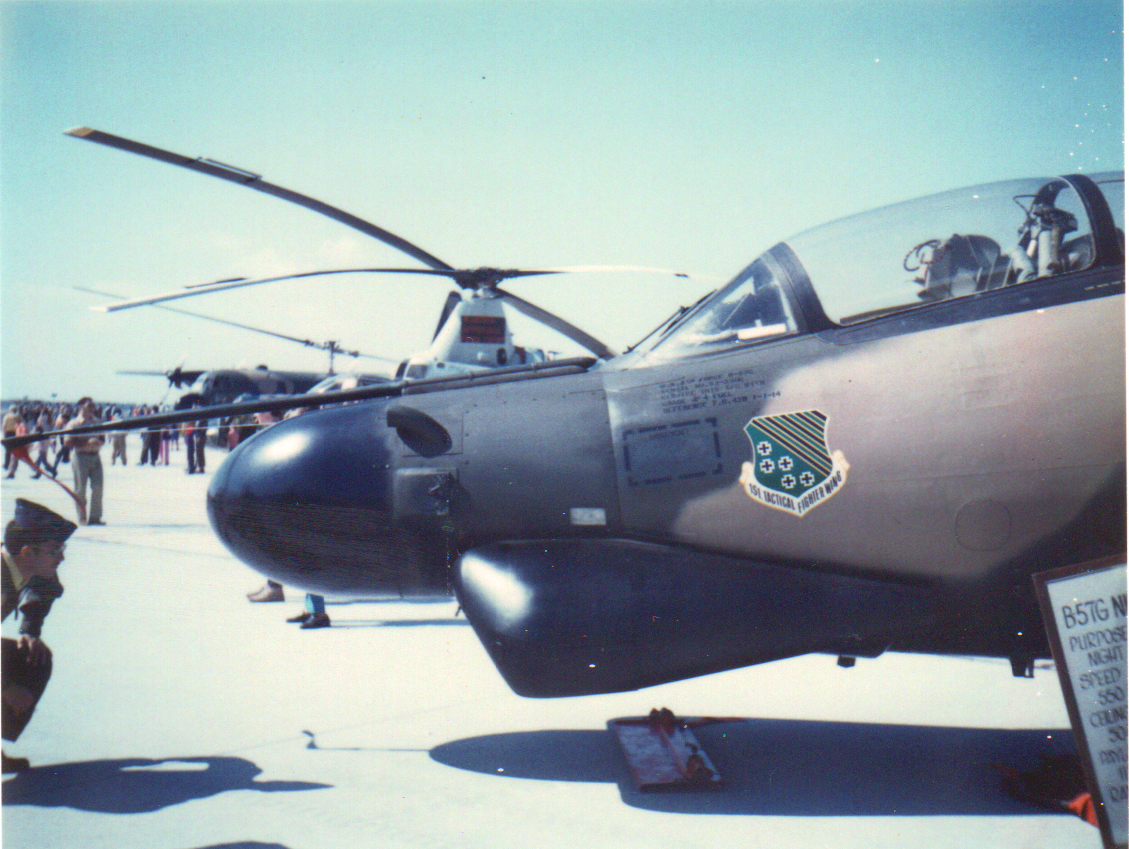
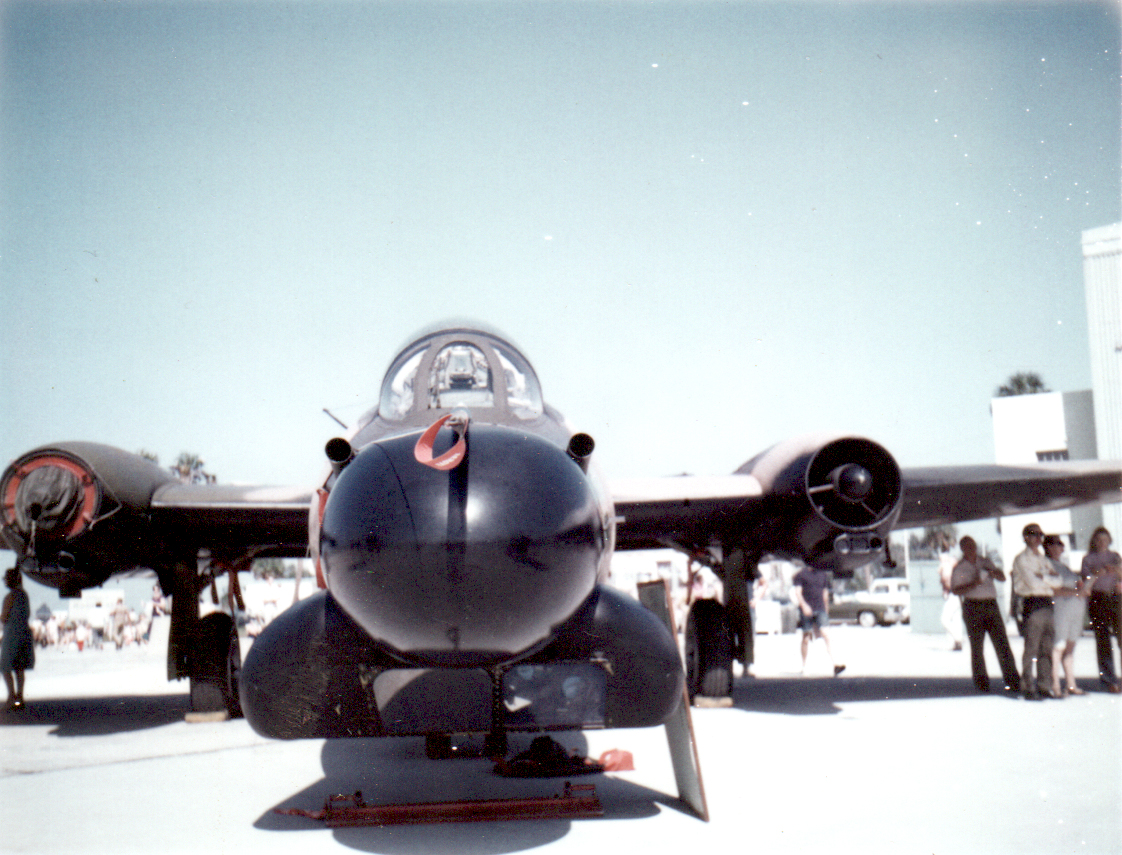
B-57G: Cockpit (Pilot's seat)

B-57G: Backseat (Weapon Controller's seat)
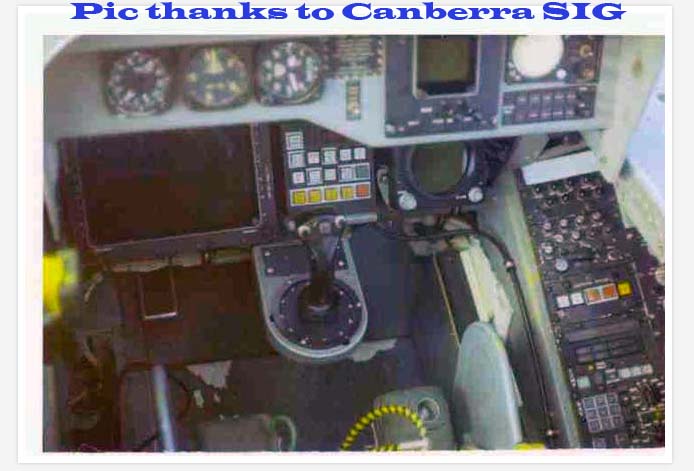
B-57G: Sensor and Avionics List
| Sensor Type | Name | Details |
|---|---|---|
| Radar | T.I. AN/APQ-139 | J-band, moving target indicating ground radar based on A-7 Corsair’s AN/APQ-126, modified for use over densly forested land |
| FLIR | T.I. FL-13 | Dual-FOV (15°×20°, 5°×7°) early forward-looking infrared system, used to detect vehicle heat sources. Also used on A-6E TRAM |
| ECM | AN/ALT-28 | Electronic countermeasure for Radar signal jamming, primarily used against SA-2 Guideline surface-air missile. Built by Hallicrafters. |
| TWDS | Westinghouse AN/AXQ-5 | Television Weapons Delivery System, used by back-seat WSO to control Radar, FLIR, laser illuminator, guided bombs and PAVE-Gat turret. |
| LLLTV | Westinghouse AN/AXQ-7 | Low-light level CCTV system, used for visual confirmation of targets. Camera uses a high-UV/low-IR range to display grayscale image. |
Out of sixteen, eleven B-57G’s were deployed in Ubon, Thailand, in September of 1970, and five remained in the United States – four for training in Tampa, Florida, and one for experimental development. The eleven B-57G’s sent to combat were tasked with striking the Ho Chi Minh trail at night. The strike aircraft were equipped with various types of bombs – conventional, incendiary, cluster, retarded, or laser-guided. The typical attack run was conducted using navigation to get close to the target area. Once in the area, targets would be spotted from range using the radar. The pilot would fly according to the sensor data, and once closer to the target, the sensor operator switched to LLLTV or FLIR for visual confirmation of the target. Once confirmed, weapons were deployed through the weapons delivery system, and the LLLTV shut-off to prevent the brightness of the bomb blast from damaging the TV. Due to various maintenance issues, the B-57G’s first combat sortie was carried out on October 17th, 1970.
Despite the remarkably poor weather in this time, the B-57G, in 543 sorties, spotted 759 trucks, attacking 565 and destroying 363. Only one aircraft would be lost due to a service accident, with its crew recovered. The B-57G’s carried out combat strikes until the widescale pull-out of U.S. forces (“Vietnamization”) from the war effort began in April of 1972. By the end of their service, the B-57G had, in 1,202 sorties, spotted 2,841 trucks, and destroyed 1,931. With their return to the United States, the B-57G’s were handed off to the Kansas ANG until their retirement in early 1974. The B-57G proved a successful proof-of-concept as a self-contained all-weather precision strike aircraft, and were successful as a developmental baseline for future precision night-attack platforms, but overall did not leave much of an impact on the battlefield when compared to the AC-130 gunship, which proved itself a far more effective truck-killing platform.
Service Record Comparison: Tropic Moon II vs. Tropic Moon III
| Tropic Moon II | Tropic Moon III | |
|---|---|---|
| Service Period | 12/1967 – 08/1968 | 10/1970 – 04/1972 |
| Total Sorties | 182 | 1,202 |
| Trucks Spotted | 456 | 2,841 |
| Trucks Destroyed | 89 | 1,931 |
| Detection rate | 2.5 trucks/sortie | 2.4 trucks/sortie |
| Kill rate | 0.2 kills/spotted | 0.7 kills/spotted |
Video of the B-57G

III. PAVE-Way: Laser-Guided
In 1965, research and development into a precision laser-guided bomb system was under way to develop a weapon which could hit targets such as bridges from a safe distance away from anti-air fire. In April of 1965, the first successful drop of an LGB was performed, using a Texas Instruments guidance kit mated to a 750 lb. M117 GP bomb. With this success, the guidance kit, KMU-342/B, was ordered into production, and the Paveway was born. The combination of seeker and M117 GP bomb was designated BOLT-117 – BOmb, Laser, Terminal guidance. While the laser-guided M117 would prove a successful introduction of the LGB concept, subsequent guided bombs would be built using Mk.80-series low-drag bombs.
The B-57G would primarily rely on the laser guided Mk.82, a 500 lb. Mk.82 which used the KMU-388/B guidance kit – later, the combination would be designated GBU-12/B. These early laser guided bombs, while accurate, were initially only carried by aircraft like the F-4D, which lacked its own self-contained guidance system to independently use LGB’s. Instead, an independent observer had to laser-designate a target, known as “buddy lasing”, or later on, a designator pod could be loaded, at the cost of some flight performance and space for more bombs.
The B-57G, however, did not have this problem. Thanks to its built-in sensor pack, which included a laser, the aircraft’s crew could use LGB’s without external assistance, the entire delivery of the weapon controlled by the back-seat weapons operator. The bombs would typically be dropped from about 6,000 ft. (~2,000 m) altitude, and guided-in using the FLIR camera. From April to June of 1971, 306 laser-guided Mk.82 bombs (GBU-12/B) were dropped, making 215 direct hits against targets, a 70% accuracy rate. The B-57G carried up to four GBU-12/B, two under each wing, however, due to limited quantities of this new and cutting edge weapon, typical combat loads carried only two LGB’s alongside cluster or incendiary munitions. The greatest limit of the B-57G’s laser-guidance capability came in the laser sensor’s gimbal limits. The laser could only point up to 4° behind the nose of the plane, meaning once the plane flew past overhead of the target, the laser would quickly lose sight of the target.
Mk.82 Paveway I (GBU-12/B) loaded under B-57G's wing


IV. PAVE-Gat: All-Seeing Gunship
Combat experience with the B-57G’s bomb loadout showed that a successful sortie could average about 6 to 8 kills using the standard configuration of four M36 incendiary cluster bombs, and two Mk.82 laser-guided bombs. On the other hand, gun-turret equipped AC-119 and AC-130 “gunships” were averaging about six times as much kills, due to their loitering capability and numerous gatling gun turrets, using different combinations of the M134 Minigun (7.62 mm) and M61 Vulcan (20 mm). To bolster the B-57G’s capabilities, a gun-based solution was sought, resulting in the PAVE-Gat project. For this project, Emerson Electric was tasked to develop a gun turret featuring the M61 Vulcan 20 mm rotary cannon, and controlled by Shed Light’s sensor systems. Two turret systems would be developed and mounted on test aircraft. The TAT-161 turret was mounted on a B-57B using the Tropic Moon II underwing pod.
B-57B with TAT-161 turret and underwing pod

The definitive PAVE-Gat aircraft was the B-57G retained in the United States, fitted with the TAT-157 turret. Using this system’s far more effective sensors and weapons control suite, it was theorized that a combination of the sensors, the aircraft’s flight performance, and an M61A1 turret fed with 4,000 rounds of 20 mm would combine the best of both the bomb-only B-57G and the two gunships in service. By March of 1970, the turret was ready for mating with the B-57G. The turret was to be controlled by the back-seater, using the same weapons control system used for sensor observation and LGB guidance. In October, Westinghouse received the B-57G, and would proceed with installing the turret.
In January 1971, testing was ready to go underway in Eglin AFB when serious problems with all B-57G radar system required the tests to be delayed, as the test platform had to be used to design a fix to the radar’s issues. A series of continued issues with the plane, unrelated to PAVE-Gat itself, continued to delay testing until May of 1971. Testing would immediately begin, and the results were promising – the modified B-57G was scoring 20 kills per sortie, triple that of the bomb-laden B-57G. With positive test results, the Air Force was eager to deploy the PAVE-Gat B-57G to Southeast Asia with the next aerial campaign. However, in August of 1971, Vietnamization of the war meant that the U.S. was to withdraw a significant portion of its military resources by early 1972. Due to the costs of deploying the PAVE-Gat B-57G, and the imminent withdrawal, it was decided that it would remain in the United States, never to see combat.
TAT-157: Design and Configuration
| TAT-157 | |
|---|---|
| Designer | Emerson Electric |
| Weapon | M61A1 20 mm rotary cannon |
| Ammo | 4,000 rounds |
| Control | Hydraulic drive |
| Size | 32.5 in. × 112 in. |
| Weight | 675 lb. (empty); 3,355 lb. (loaded) |
| Azimuth | Left: -30° – Right: +30° |
| Elevation | Max: -20° – Min: -105° |
| Turret at -12° elevation when stowed |
Video of the PAVE-Gat system in testing

V. B-57G: Performance and Loadout
| Performance | Statistics |
|---|---|
| Wingspan | 64’ 0" (19.5 m) |
| Length | 65’ 6" (20 m) |
| Height | 14’ 10" (4.5 m) |
| Empty Mass | 27,091 lb. (12,288 kg) |
| Engine | Wright J65-W-5D (×2) |
| Total Thrust | 14,440 lb. (6,550 kg) |
| Max. Speed | 575 mph @ Sea Level |
| Max. Altitude | 45,100 ft (13,747 m) |
| Combat Range | 948 mi (1,525 km) |
| Weapons Loadout | Description | Location |
|---|---|---|
| 500 lb. AN/M64 (×9) | General purpose bomb | Bomb bay |
| 750 lb. M117 (×4) | General purpose bomb | Bomb bay |
| 750 lb. M36E2 (×4) | Incendiary cluster bomb | Bomb bay |
| 500 lb. Mk.82 (×4) | General purpose bomb | Wing pylons |
| 500 lb. Mk.82 Snake Eye (×4) | High-drag bomb | Wing pylons |
| 500 lb. GBU-12/B (×4) | Laser guided bomb | Wing pylons |
| TAT-157 Gun Turret | M61 20 mm cannon (Ammo: 4,000) | Ventral mount |
B-57G loaded with two GBU-12/B and four M36E2 incendiary bombs

B-57G loaded with nine AN/M64 bombs in rotary bomb rack

B-57G loaded with a pair of laser-guided Mk.82, Ubon, Thailand


B-57G: Additional Photographs
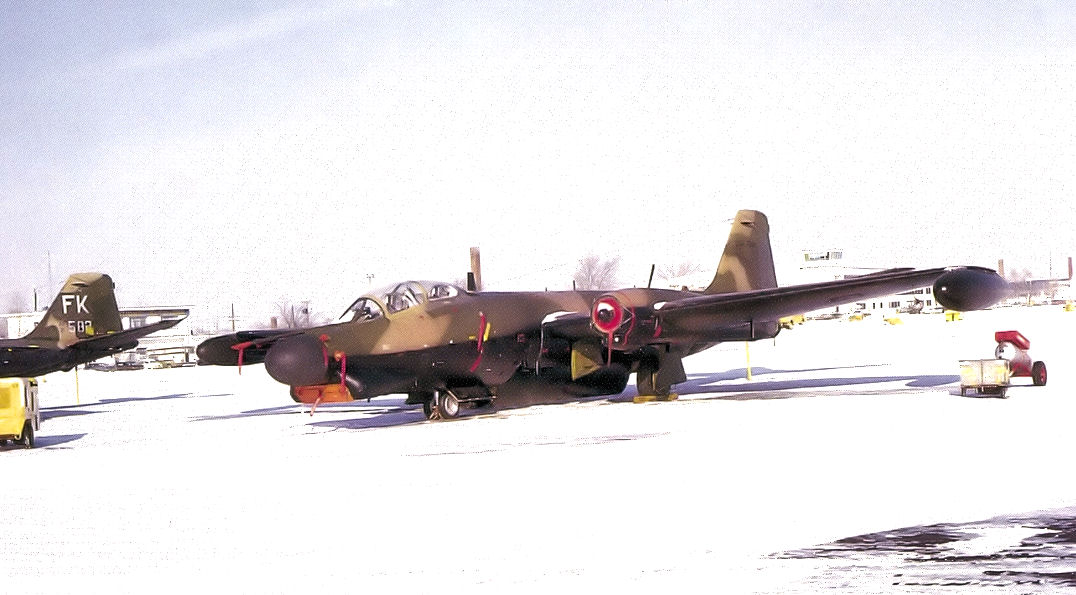





VI. Citations
Performance and Operational History:
- The B-57G – Tropic Moon III
- Moon Over The Trail: A Review of Operations Sped Light And Tropic Moon III. - Document - Gale Academic OneFile
- The Air War against North Vietnam: the Thanh Hoa Railroad and Highway Bridge (Part 5). - Document - Gale Academic OneFile
- Development and Employment of Fixed-Wing Gunships, 1962-1972
- 13th Bombardment Squadron History
- The Martin B-57G; Laid the Groundwork - Forgotten Aircraft - Military Matters
- Martin B-57B
- Martin B-57G
- [3.0] The Martin B-57
- Operation Shed light
- B-57G chin - Aircraft Cold War - Britmodeller.com
Sensors and Avionics:
- The History of Forward-Looking Infrared (FLIR), pg. 44
- AN/AWA to AN/AYW - Equipment Listing
- AN/ALQ to AN/ALT - Equipment Listing
Weapons and Munitions:






